The adherence to the law for corporations
VerifiedAdded on 2022/08/26
|15
|3544
|8
AI Summary
Contribute Materials
Your contribution can guide someone’s learning journey. Share your
documents today.
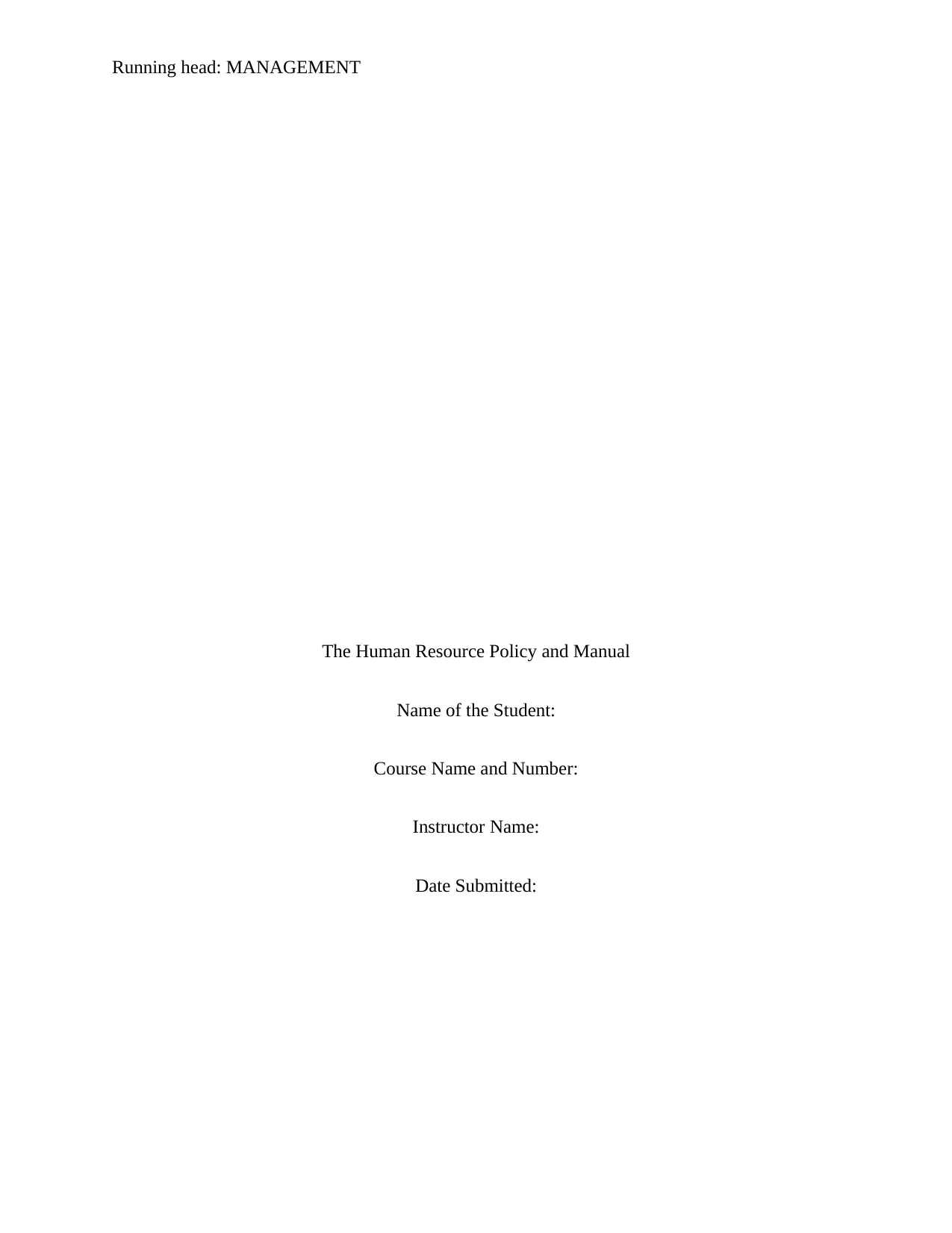
Running head: MANAGEMENT
The Human Resource Policy and Manual
Name of the Student:
Course Name and Number:
Instructor Name:
Date Submitted:
The Human Resource Policy and Manual
Name of the Student:
Course Name and Number:
Instructor Name:
Date Submitted:
Secure Best Marks with AI Grader
Need help grading? Try our AI Grader for instant feedback on your assignments.
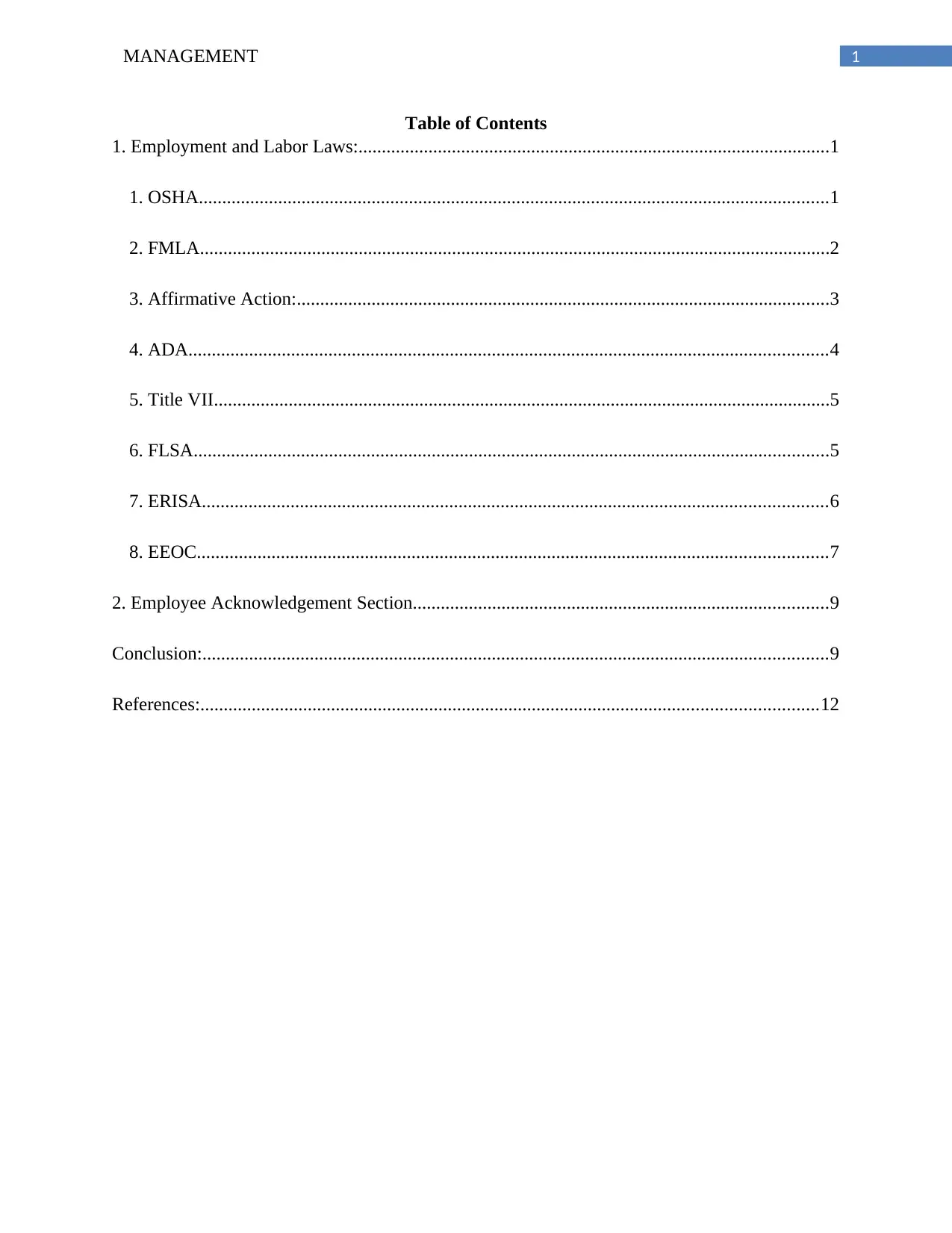
MANAGEMENT 1
Table of Contents
1. Employment and Labor Laws:.....................................................................................................1
1. OSHA.......................................................................................................................................1
2. FMLA.......................................................................................................................................2
3. Affirmative Action:..................................................................................................................3
4. ADA.........................................................................................................................................4
5. Title VII....................................................................................................................................5
6. FLSA........................................................................................................................................5
7. ERISA......................................................................................................................................6
8. EEOC.......................................................................................................................................7
2. Employee Acknowledgement Section.........................................................................................9
Conclusion:......................................................................................................................................9
References:....................................................................................................................................12
Table of Contents
1. Employment and Labor Laws:.....................................................................................................1
1. OSHA.......................................................................................................................................1
2. FMLA.......................................................................................................................................2
3. Affirmative Action:..................................................................................................................3
4. ADA.........................................................................................................................................4
5. Title VII....................................................................................................................................5
6. FLSA........................................................................................................................................5
7. ERISA......................................................................................................................................6
8. EEOC.......................................................................................................................................7
2. Employee Acknowledgement Section.........................................................................................9
Conclusion:......................................................................................................................................9
References:....................................................................................................................................12
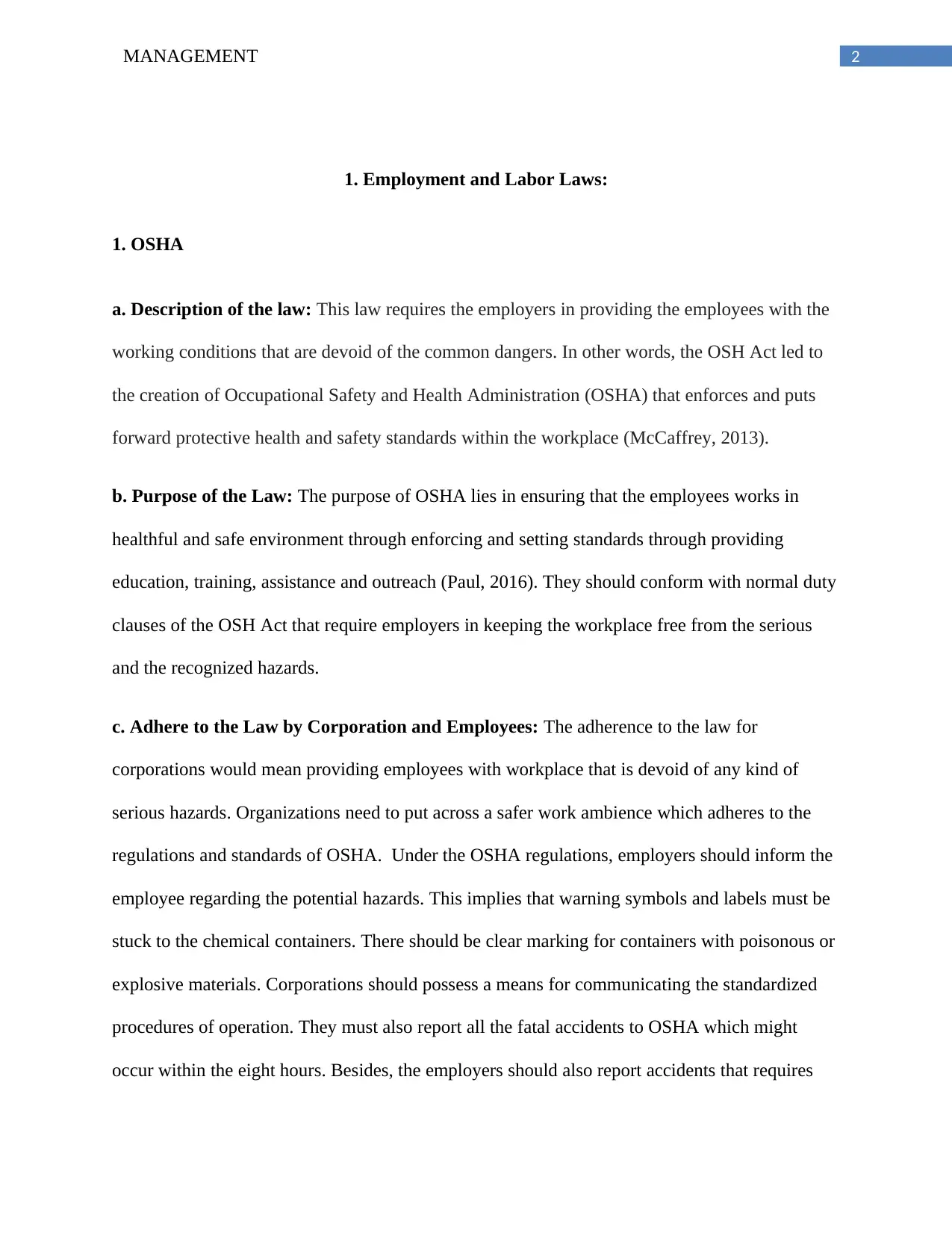
2MANAGEMENT
1. Employment and Labor Laws:
1. OSHA
a. Description of the law: This law requires the employers in providing the employees with the
working conditions that are devoid of the common dangers. In other words, the OSH Act led to
the creation of Occupational Safety and Health Administration (OSHA) that enforces and puts
forward protective health and safety standards within the workplace (McCaffrey, 2013).
b. Purpose of the Law: The purpose of OSHA lies in ensuring that the employees works in
healthful and safe environment through enforcing and setting standards through providing
education, training, assistance and outreach (Paul, 2016). They should conform with normal duty
clauses of the OSH Act that require employers in keeping the workplace free from the serious
and the recognized hazards.
c. Adhere to the Law by Corporation and Employees: The adherence to the law for
corporations would mean providing employees with workplace that is devoid of any kind of
serious hazards. Organizations need to put across a safer work ambience which adheres to the
regulations and standards of OSHA. Under the OSHA regulations, employers should inform the
employee regarding the potential hazards. This implies that warning symbols and labels must be
stuck to the chemical containers. There should be clear marking for containers with poisonous or
explosive materials. Corporations should possess a means for communicating the standardized
procedures of operation. They must also report all the fatal accidents to OSHA which might
occur within the eight hours. Besides, the employers should also report accidents that requires
1. Employment and Labor Laws:
1. OSHA
a. Description of the law: This law requires the employers in providing the employees with the
working conditions that are devoid of the common dangers. In other words, the OSH Act led to
the creation of Occupational Safety and Health Administration (OSHA) that enforces and puts
forward protective health and safety standards within the workplace (McCaffrey, 2013).
b. Purpose of the Law: The purpose of OSHA lies in ensuring that the employees works in
healthful and safe environment through enforcing and setting standards through providing
education, training, assistance and outreach (Paul, 2016). They should conform with normal duty
clauses of the OSH Act that require employers in keeping the workplace free from the serious
and the recognized hazards.
c. Adhere to the Law by Corporation and Employees: The adherence to the law for
corporations would mean providing employees with workplace that is devoid of any kind of
serious hazards. Organizations need to put across a safer work ambience which adheres to the
regulations and standards of OSHA. Under the OSHA regulations, employers should inform the
employee regarding the potential hazards. This implies that warning symbols and labels must be
stuck to the chemical containers. There should be clear marking for containers with poisonous or
explosive materials. Corporations should possess a means for communicating the standardized
procedures of operation. They must also report all the fatal accidents to OSHA which might
occur within the eight hours. Besides, the employers should also report accidents that requires
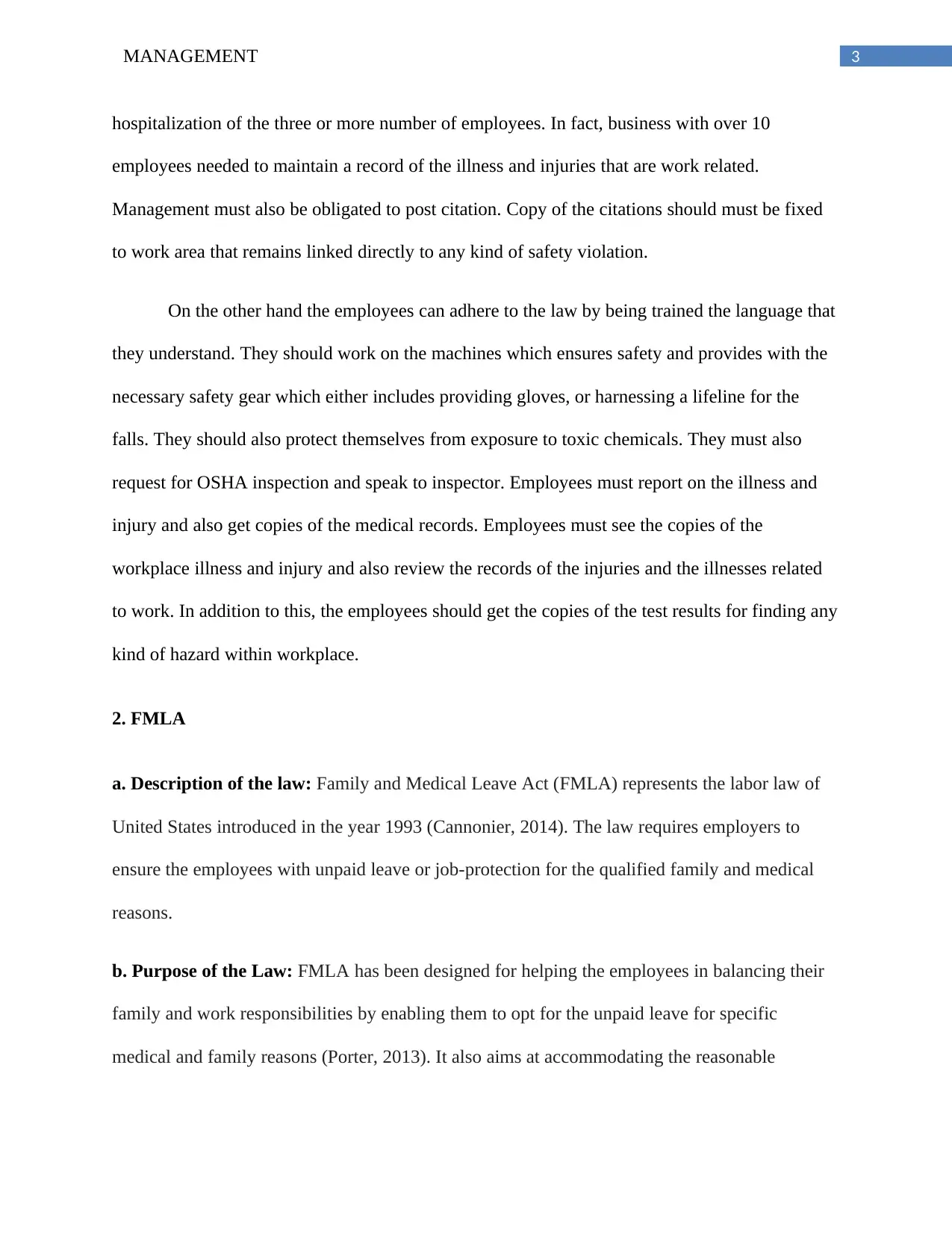
3MANAGEMENT
hospitalization of the three or more number of employees. In fact, business with over 10
employees needed to maintain a record of the illness and injuries that are work related.
Management must also be obligated to post citation. Copy of the citations should must be fixed
to work area that remains linked directly to any kind of safety violation.
On the other hand the employees can adhere to the law by being trained the language that
they understand. They should work on the machines which ensures safety and provides with the
necessary safety gear which either includes providing gloves, or harnessing a lifeline for the
falls. They should also protect themselves from exposure to toxic chemicals. They must also
request for OSHA inspection and speak to inspector. Employees must report on the illness and
injury and also get copies of the medical records. Employees must see the copies of the
workplace illness and injury and also review the records of the injuries and the illnesses related
to work. In addition to this, the employees should get the copies of the test results for finding any
kind of hazard within workplace.
2. FMLA
a. Description of the law: Family and Medical Leave Act (FMLA) represents the labor law of
United States introduced in the year 1993 (Cannonier, 2014). The law requires employers to
ensure the employees with unpaid leave or job-protection for the qualified family and medical
reasons.
b. Purpose of the Law: FMLA has been designed for helping the employees in balancing their
family and work responsibilities by enabling them to opt for the unpaid leave for specific
medical and family reasons (Porter, 2013). It also aims at accommodating the reasonable
hospitalization of the three or more number of employees. In fact, business with over 10
employees needed to maintain a record of the illness and injuries that are work related.
Management must also be obligated to post citation. Copy of the citations should must be fixed
to work area that remains linked directly to any kind of safety violation.
On the other hand the employees can adhere to the law by being trained the language that
they understand. They should work on the machines which ensures safety and provides with the
necessary safety gear which either includes providing gloves, or harnessing a lifeline for the
falls. They should also protect themselves from exposure to toxic chemicals. They must also
request for OSHA inspection and speak to inspector. Employees must report on the illness and
injury and also get copies of the medical records. Employees must see the copies of the
workplace illness and injury and also review the records of the injuries and the illnesses related
to work. In addition to this, the employees should get the copies of the test results for finding any
kind of hazard within workplace.
2. FMLA
a. Description of the law: Family and Medical Leave Act (FMLA) represents the labor law of
United States introduced in the year 1993 (Cannonier, 2014). The law requires employers to
ensure the employees with unpaid leave or job-protection for the qualified family and medical
reasons.
b. Purpose of the Law: FMLA has been designed for helping the employees in balancing their
family and work responsibilities by enabling them to opt for the unpaid leave for specific
medical and family reasons (Porter, 2013). It also aims at accommodating the reasonable
Secure Best Marks with AI Grader
Need help grading? Try our AI Grader for instant feedback on your assignments.
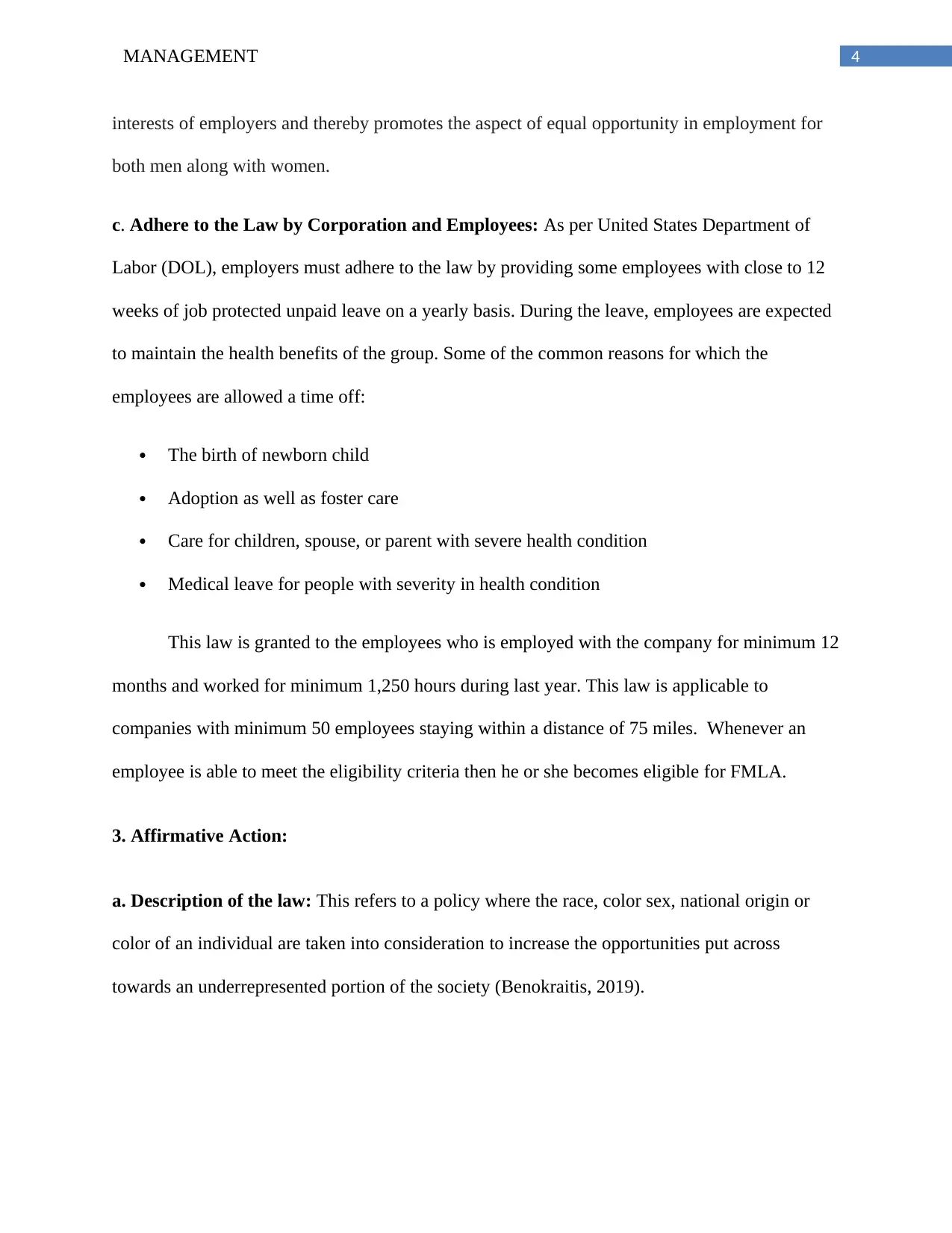
4MANAGEMENT
interests of employers and thereby promotes the aspect of equal opportunity in employment for
both men along with women.
c. Adhere to the Law by Corporation and Employees: As per United States Department of
Labor (DOL), employers must adhere to the law by providing some employees with close to 12
weeks of job protected unpaid leave on a yearly basis. During the leave, employees are expected
to maintain the health benefits of the group. Some of the common reasons for which the
employees are allowed a time off:
The birth of newborn child
Adoption as well as foster care
Care for children, spouse, or parent with severe health condition
Medical leave for people with severity in health condition
This law is granted to the employees who is employed with the company for minimum 12
months and worked for minimum 1,250 hours during last year. This law is applicable to
companies with minimum 50 employees staying within a distance of 75 miles. Whenever an
employee is able to meet the eligibility criteria then he or she becomes eligible for FMLA.
3. Affirmative Action:
a. Description of the law: This refers to a policy where the race, color sex, national origin or
color of an individual are taken into consideration to increase the opportunities put across
towards an underrepresented portion of the society (Benokraitis, 2019).
interests of employers and thereby promotes the aspect of equal opportunity in employment for
both men along with women.
c. Adhere to the Law by Corporation and Employees: As per United States Department of
Labor (DOL), employers must adhere to the law by providing some employees with close to 12
weeks of job protected unpaid leave on a yearly basis. During the leave, employees are expected
to maintain the health benefits of the group. Some of the common reasons for which the
employees are allowed a time off:
The birth of newborn child
Adoption as well as foster care
Care for children, spouse, or parent with severe health condition
Medical leave for people with severity in health condition
This law is granted to the employees who is employed with the company for minimum 12
months and worked for minimum 1,250 hours during last year. This law is applicable to
companies with minimum 50 employees staying within a distance of 75 miles. Whenever an
employee is able to meet the eligibility criteria then he or she becomes eligible for FMLA.
3. Affirmative Action:
a. Description of the law: This refers to a policy where the race, color sex, national origin or
color of an individual are taken into consideration to increase the opportunities put across
towards an underrepresented portion of the society (Benokraitis, 2019).
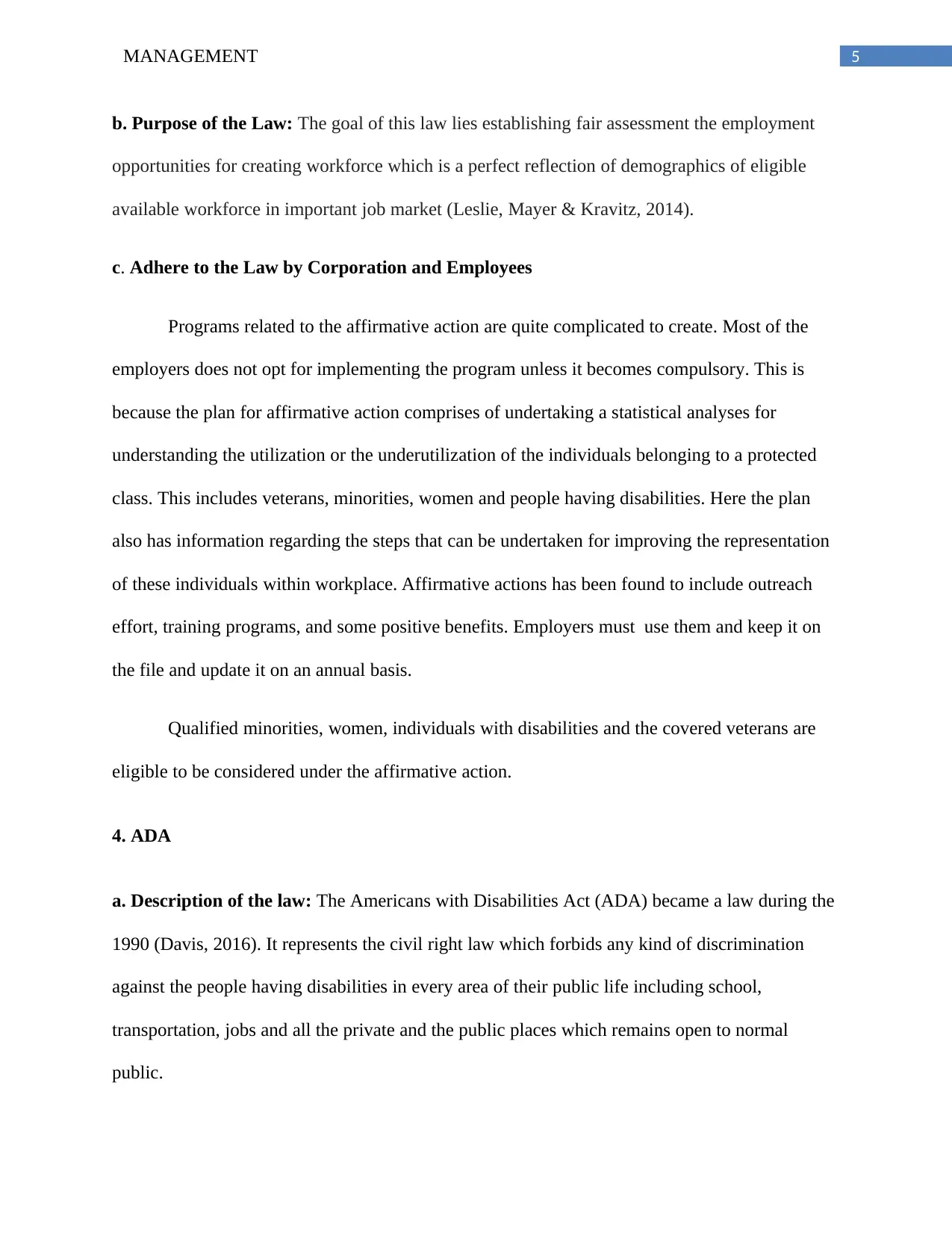
5MANAGEMENT
b. Purpose of the Law: The goal of this law lies establishing fair assessment the employment
opportunities for creating workforce which is a perfect reflection of demographics of eligible
available workforce in important job market (Leslie, Mayer & Kravitz, 2014).
c. Adhere to the Law by Corporation and Employees
Programs related to the affirmative action are quite complicated to create. Most of the
employers does not opt for implementing the program unless it becomes compulsory. This is
because the plan for affirmative action comprises of undertaking a statistical analyses for
understanding the utilization or the underutilization of the individuals belonging to a protected
class. This includes veterans, minorities, women and people having disabilities. Here the plan
also has information regarding the steps that can be undertaken for improving the representation
of these individuals within workplace. Affirmative actions has been found to include outreach
effort, training programs, and some positive benefits. Employers must use them and keep it on
the file and update it on an annual basis.
Qualified minorities, women, individuals with disabilities and the covered veterans are
eligible to be considered under the affirmative action.
4. ADA
a. Description of the law: The Americans with Disabilities Act (ADA) became a law during the
1990 (Davis, 2016). It represents the civil right law which forbids any kind of discrimination
against the people having disabilities in every area of their public life including school,
transportation, jobs and all the private and the public places which remains open to normal
public.
b. Purpose of the Law: The goal of this law lies establishing fair assessment the employment
opportunities for creating workforce which is a perfect reflection of demographics of eligible
available workforce in important job market (Leslie, Mayer & Kravitz, 2014).
c. Adhere to the Law by Corporation and Employees
Programs related to the affirmative action are quite complicated to create. Most of the
employers does not opt for implementing the program unless it becomes compulsory. This is
because the plan for affirmative action comprises of undertaking a statistical analyses for
understanding the utilization or the underutilization of the individuals belonging to a protected
class. This includes veterans, minorities, women and people having disabilities. Here the plan
also has information regarding the steps that can be undertaken for improving the representation
of these individuals within workplace. Affirmative actions has been found to include outreach
effort, training programs, and some positive benefits. Employers must use them and keep it on
the file and update it on an annual basis.
Qualified minorities, women, individuals with disabilities and the covered veterans are
eligible to be considered under the affirmative action.
4. ADA
a. Description of the law: The Americans with Disabilities Act (ADA) became a law during the
1990 (Davis, 2016). It represents the civil right law which forbids any kind of discrimination
against the people having disabilities in every area of their public life including school,
transportation, jobs and all the private and the public places which remains open to normal
public.
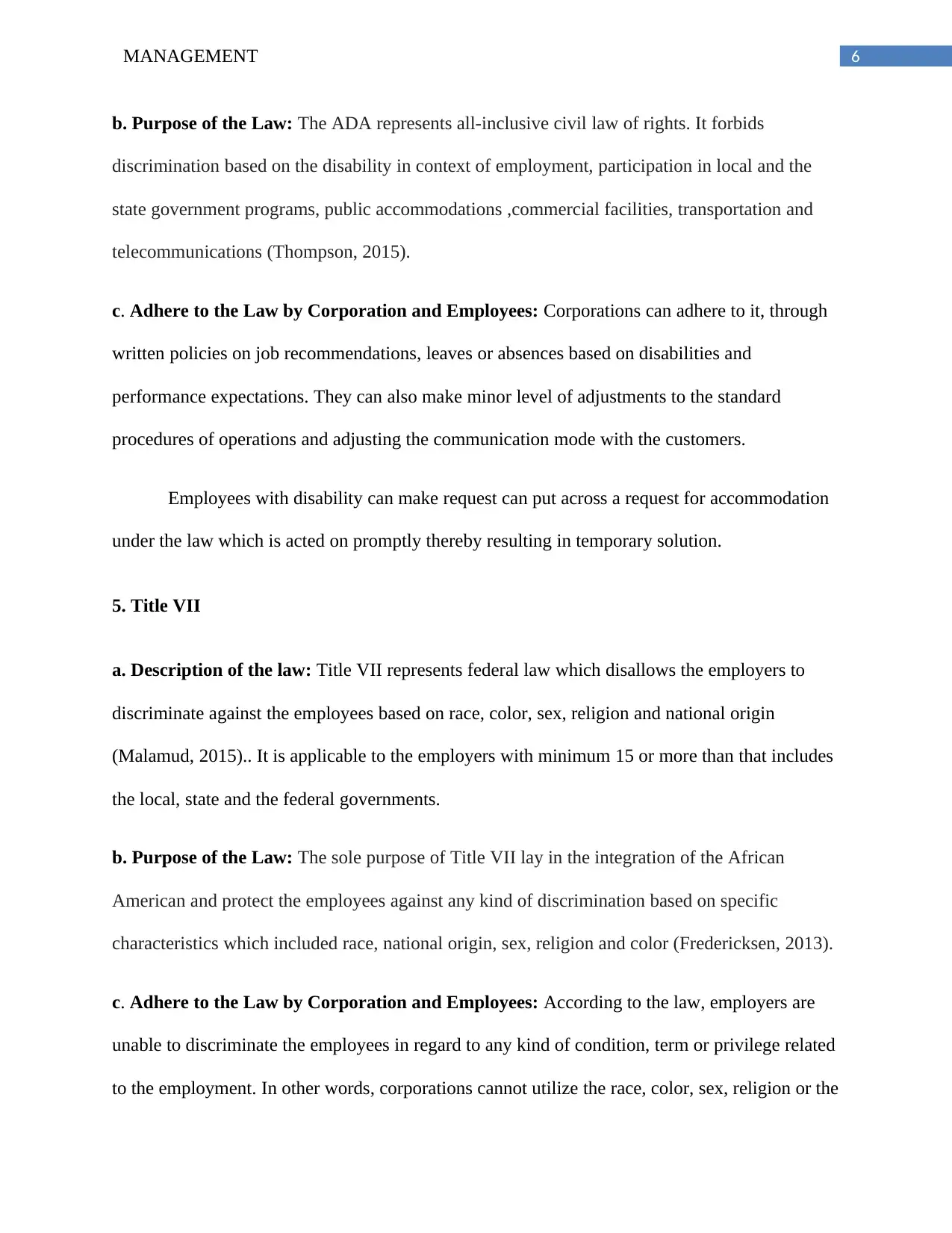
6MANAGEMENT
b. Purpose of the Law: The ADA represents all-inclusive civil law of rights. It forbids
discrimination based on the disability in context of employment, participation in local and the
state government programs, public accommodations ,commercial facilities, transportation and
telecommunications (Thompson, 2015).
c. Adhere to the Law by Corporation and Employees: Corporations can adhere to it, through
written policies on job recommendations, leaves or absences based on disabilities and
performance expectations. They can also make minor level of adjustments to the standard
procedures of operations and adjusting the communication mode with the customers.
Employees with disability can make request can put across a request for accommodation
under the law which is acted on promptly thereby resulting in temporary solution.
5. Title VII
a. Description of the law: Title VII represents federal law which disallows the employers to
discriminate against the employees based on race, color, sex, religion and national origin
(Malamud, 2015).. It is applicable to the employers with minimum 15 or more than that includes
the local, state and the federal governments.
b. Purpose of the Law: The sole purpose of Title VII lay in the integration of the African
American and protect the employees against any kind of discrimination based on specific
characteristics which included race, national origin, sex, religion and color (Fredericksen, 2013).
c. Adhere to the Law by Corporation and Employees: According to the law, employers are
unable to discriminate the employees in regard to any kind of condition, term or privilege related
to the employment. In other words, corporations cannot utilize the race, color, sex, religion or the
b. Purpose of the Law: The ADA represents all-inclusive civil law of rights. It forbids
discrimination based on the disability in context of employment, participation in local and the
state government programs, public accommodations ,commercial facilities, transportation and
telecommunications (Thompson, 2015).
c. Adhere to the Law by Corporation and Employees: Corporations can adhere to it, through
written policies on job recommendations, leaves or absences based on disabilities and
performance expectations. They can also make minor level of adjustments to the standard
procedures of operations and adjusting the communication mode with the customers.
Employees with disability can make request can put across a request for accommodation
under the law which is acted on promptly thereby resulting in temporary solution.
5. Title VII
a. Description of the law: Title VII represents federal law which disallows the employers to
discriminate against the employees based on race, color, sex, religion and national origin
(Malamud, 2015).. It is applicable to the employers with minimum 15 or more than that includes
the local, state and the federal governments.
b. Purpose of the Law: The sole purpose of Title VII lay in the integration of the African
American and protect the employees against any kind of discrimination based on specific
characteristics which included race, national origin, sex, religion and color (Fredericksen, 2013).
c. Adhere to the Law by Corporation and Employees: According to the law, employers are
unable to discriminate the employees in regard to any kind of condition, term or privilege related
to the employment. In other words, corporations cannot utilize the race, color, sex, religion or the
Paraphrase This Document
Need a fresh take? Get an instant paraphrase of this document with our AI Paraphraser
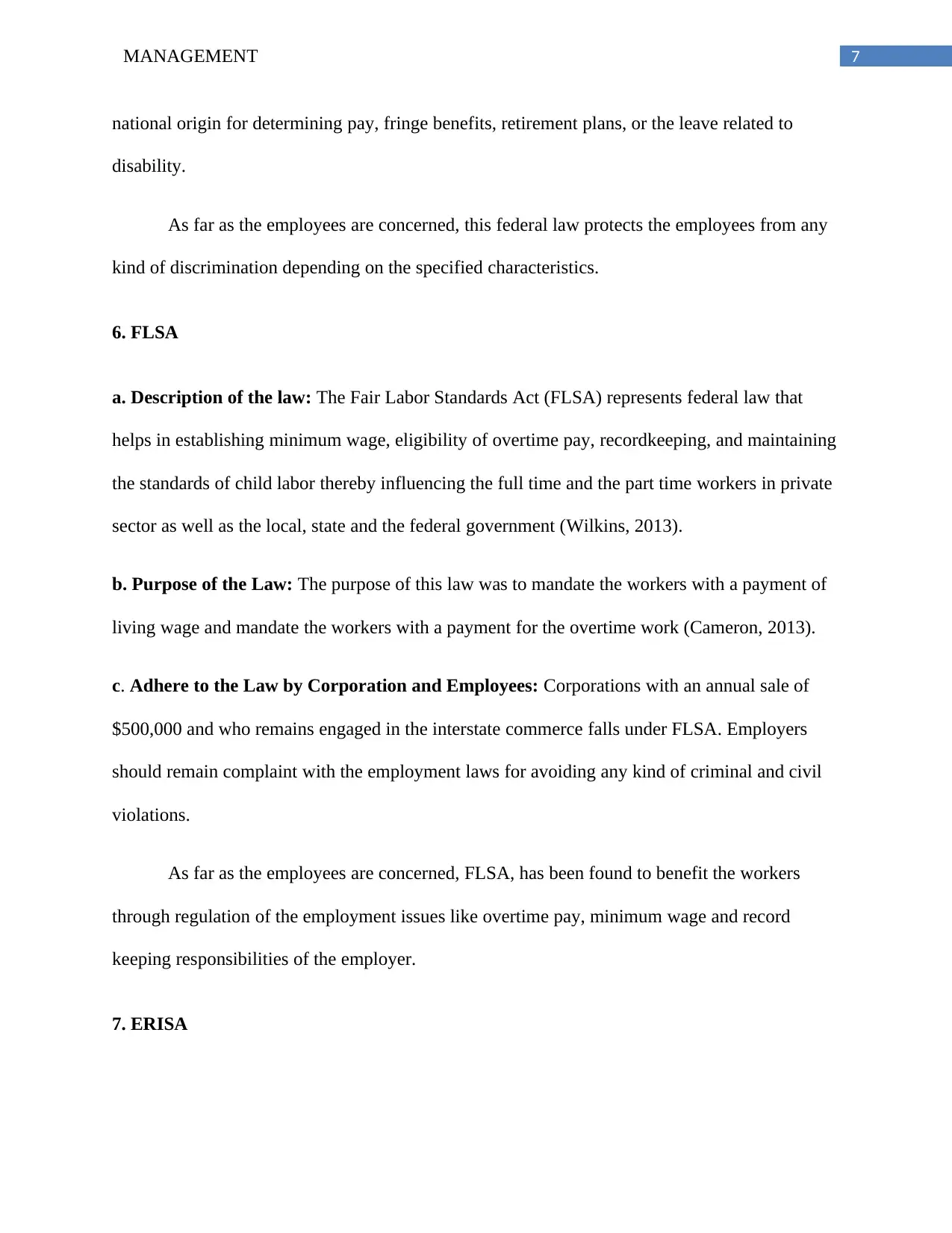
7MANAGEMENT
national origin for determining pay, fringe benefits, retirement plans, or the leave related to
disability.
As far as the employees are concerned, this federal law protects the employees from any
kind of discrimination depending on the specified characteristics.
6. FLSA
a. Description of the law: The Fair Labor Standards Act (FLSA) represents federal law that
helps in establishing minimum wage, eligibility of overtime pay, recordkeeping, and maintaining
the standards of child labor thereby influencing the full time and the part time workers in private
sector as well as the local, state and the federal government (Wilkins, 2013).
b. Purpose of the Law: The purpose of this law was to mandate the workers with a payment of
living wage and mandate the workers with a payment for the overtime work (Cameron, 2013).
c. Adhere to the Law by Corporation and Employees: Corporations with an annual sale of
$500,000 and who remains engaged in the interstate commerce falls under FLSA. Employers
should remain complaint with the employment laws for avoiding any kind of criminal and civil
violations.
As far as the employees are concerned, FLSA, has been found to benefit the workers
through regulation of the employment issues like overtime pay, minimum wage and record
keeping responsibilities of the employer.
7. ERISA
national origin for determining pay, fringe benefits, retirement plans, or the leave related to
disability.
As far as the employees are concerned, this federal law protects the employees from any
kind of discrimination depending on the specified characteristics.
6. FLSA
a. Description of the law: The Fair Labor Standards Act (FLSA) represents federal law that
helps in establishing minimum wage, eligibility of overtime pay, recordkeeping, and maintaining
the standards of child labor thereby influencing the full time and the part time workers in private
sector as well as the local, state and the federal government (Wilkins, 2013).
b. Purpose of the Law: The purpose of this law was to mandate the workers with a payment of
living wage and mandate the workers with a payment for the overtime work (Cameron, 2013).
c. Adhere to the Law by Corporation and Employees: Corporations with an annual sale of
$500,000 and who remains engaged in the interstate commerce falls under FLSA. Employers
should remain complaint with the employment laws for avoiding any kind of criminal and civil
violations.
As far as the employees are concerned, FLSA, has been found to benefit the workers
through regulation of the employment issues like overtime pay, minimum wage and record
keeping responsibilities of the employer.
7. ERISA
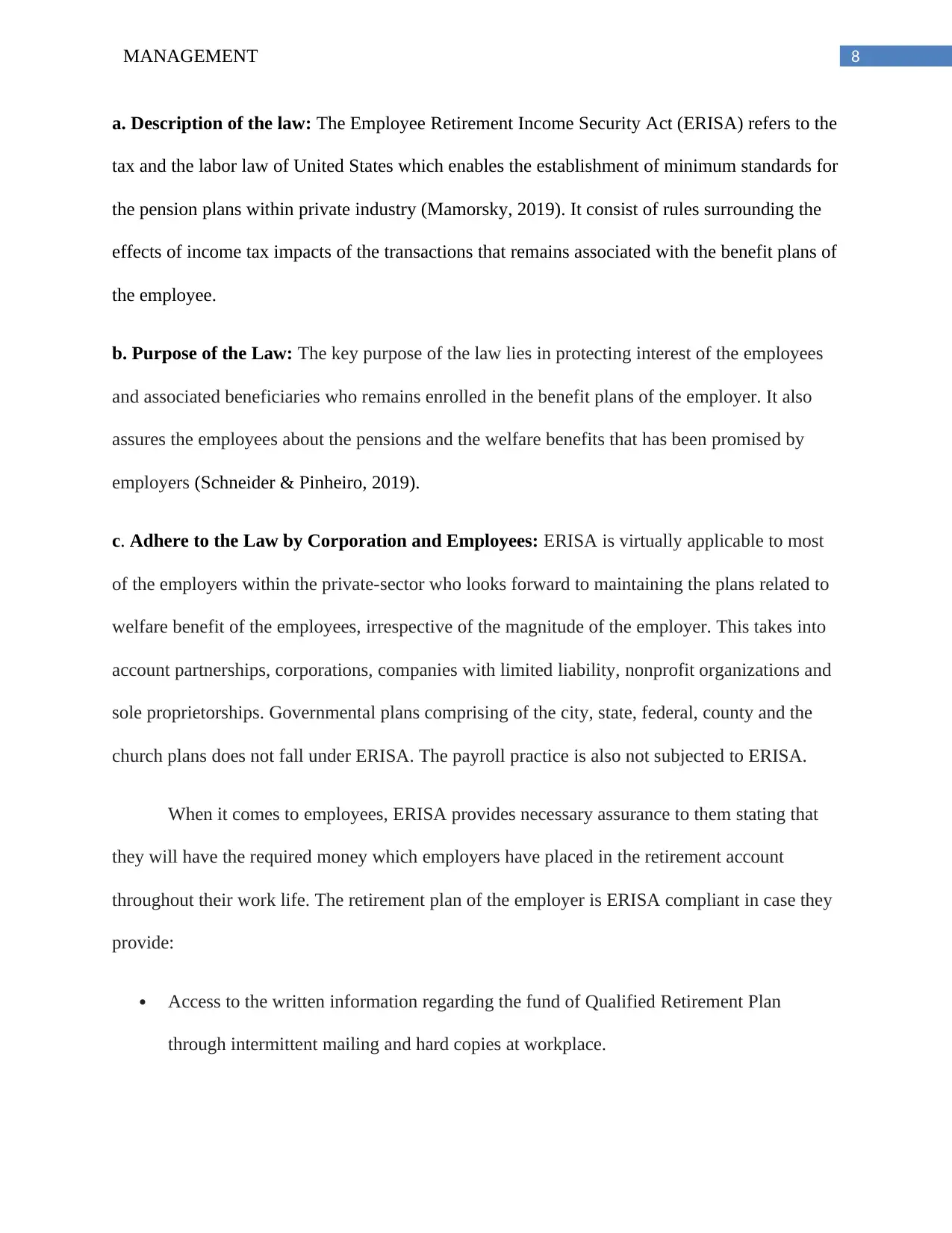
8MANAGEMENT
a. Description of the law: The Employee Retirement Income Security Act (ERISA) refers to the
tax and the labor law of United States which enables the establishment of minimum standards for
the pension plans within private industry (Mamorsky, 2019). It consist of rules surrounding the
effects of income tax impacts of the transactions that remains associated with the benefit plans of
the employee.
b. Purpose of the Law: The key purpose of the law lies in protecting interest of the employees
and associated beneficiaries who remains enrolled in the benefit plans of the employer. It also
assures the employees about the pensions and the welfare benefits that has been promised by
employers (Schneider & Pinheiro, 2019).
c. Adhere to the Law by Corporation and Employees: ERISA is virtually applicable to most
of the employers within the private-sector who looks forward to maintaining the plans related to
welfare benefit of the employees, irrespective of the magnitude of the employer. This takes into
account partnerships, corporations, companies with limited liability, nonprofit organizations and
sole proprietorships. Governmental plans comprising of the city, state, federal, county and the
church plans does not fall under ERISA. The payroll practice is also not subjected to ERISA.
When it comes to employees, ERISA provides necessary assurance to them stating that
they will have the required money which employers have placed in the retirement account
throughout their work life. The retirement plan of the employer is ERISA compliant in case they
provide:
Access to the written information regarding the fund of Qualified Retirement Plan
through intermittent mailing and hard copies at workplace.
a. Description of the law: The Employee Retirement Income Security Act (ERISA) refers to the
tax and the labor law of United States which enables the establishment of minimum standards for
the pension plans within private industry (Mamorsky, 2019). It consist of rules surrounding the
effects of income tax impacts of the transactions that remains associated with the benefit plans of
the employee.
b. Purpose of the Law: The key purpose of the law lies in protecting interest of the employees
and associated beneficiaries who remains enrolled in the benefit plans of the employer. It also
assures the employees about the pensions and the welfare benefits that has been promised by
employers (Schneider & Pinheiro, 2019).
c. Adhere to the Law by Corporation and Employees: ERISA is virtually applicable to most
of the employers within the private-sector who looks forward to maintaining the plans related to
welfare benefit of the employees, irrespective of the magnitude of the employer. This takes into
account partnerships, corporations, companies with limited liability, nonprofit organizations and
sole proprietorships. Governmental plans comprising of the city, state, federal, county and the
church plans does not fall under ERISA. The payroll practice is also not subjected to ERISA.
When it comes to employees, ERISA provides necessary assurance to them stating that
they will have the required money which employers have placed in the retirement account
throughout their work life. The retirement plan of the employer is ERISA compliant in case they
provide:
Access to the written information regarding the fund of Qualified Retirement Plan
through intermittent mailing and hard copies at workplace.
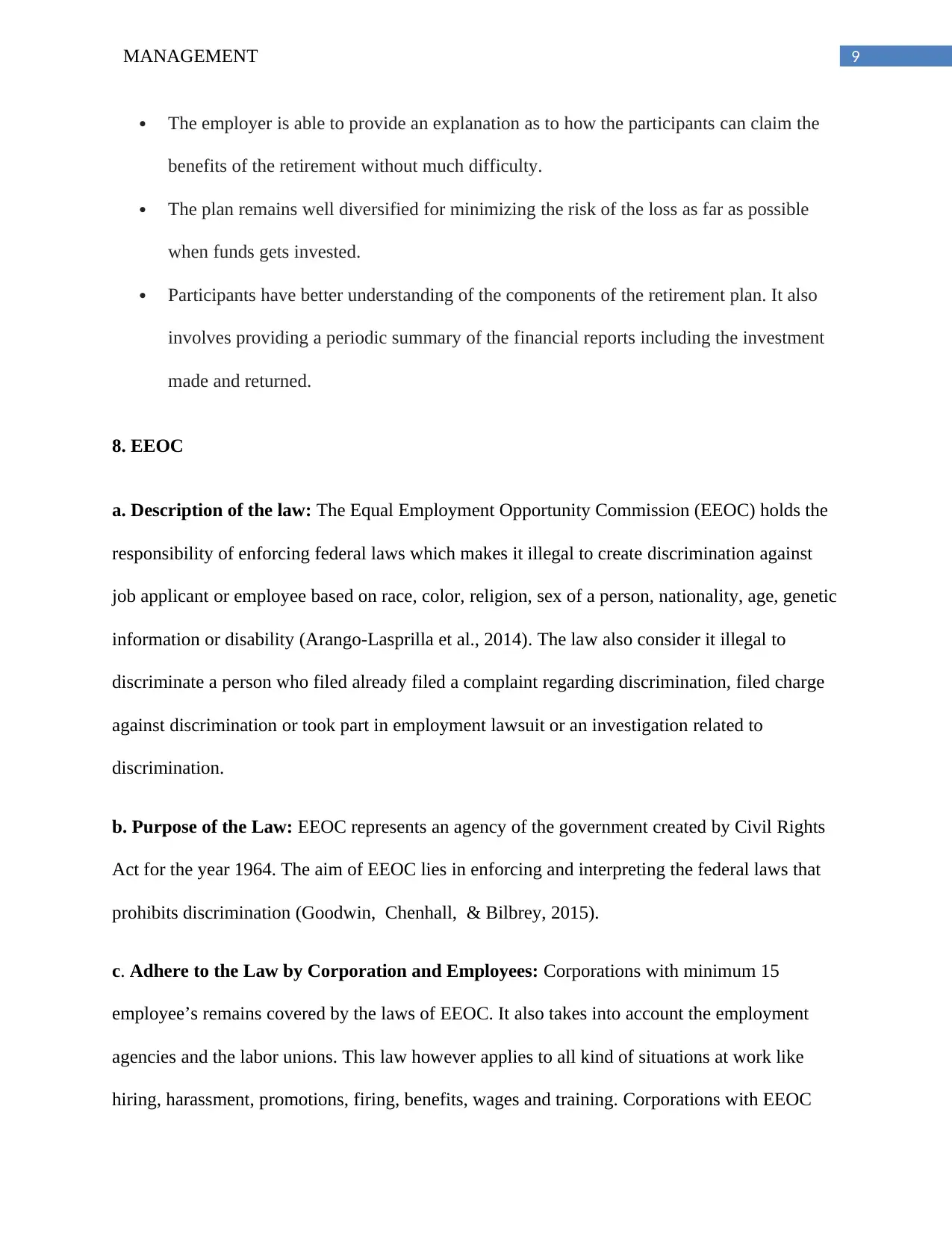
9MANAGEMENT
The employer is able to provide an explanation as to how the participants can claim the
benefits of the retirement without much difficulty.
The plan remains well diversified for minimizing the risk of the loss as far as possible
when funds gets invested.
Participants have better understanding of the components of the retirement plan. It also
involves providing a periodic summary of the financial reports including the investment
made and returned.
8. EEOC
a. Description of the law: The Equal Employment Opportunity Commission (EEOC) holds the
responsibility of enforcing federal laws which makes it illegal to create discrimination against
job applicant or employee based on race, color, religion, sex of a person, nationality, age, genetic
information or disability (Arango-Lasprilla et al., 2014). The law also consider it illegal to
discriminate a person who filed already filed a complaint regarding discrimination, filed charge
against discrimination or took part in employment lawsuit or an investigation related to
discrimination.
b. Purpose of the Law: EEOC represents an agency of the government created by Civil Rights
Act for the year 1964. The aim of EEOC lies in enforcing and interpreting the federal laws that
prohibits discrimination (Goodwin, Chenhall, & Bilbrey, 2015).
c. Adhere to the Law by Corporation and Employees: Corporations with minimum 15
employee’s remains covered by the laws of EEOC. It also takes into account the employment
agencies and the labor unions. This law however applies to all kind of situations at work like
hiring, harassment, promotions, firing, benefits, wages and training. Corporations with EEOC
The employer is able to provide an explanation as to how the participants can claim the
benefits of the retirement without much difficulty.
The plan remains well diversified for minimizing the risk of the loss as far as possible
when funds gets invested.
Participants have better understanding of the components of the retirement plan. It also
involves providing a periodic summary of the financial reports including the investment
made and returned.
8. EEOC
a. Description of the law: The Equal Employment Opportunity Commission (EEOC) holds the
responsibility of enforcing federal laws which makes it illegal to create discrimination against
job applicant or employee based on race, color, religion, sex of a person, nationality, age, genetic
information or disability (Arango-Lasprilla et al., 2014). The law also consider it illegal to
discriminate a person who filed already filed a complaint regarding discrimination, filed charge
against discrimination or took part in employment lawsuit or an investigation related to
discrimination.
b. Purpose of the Law: EEOC represents an agency of the government created by Civil Rights
Act for the year 1964. The aim of EEOC lies in enforcing and interpreting the federal laws that
prohibits discrimination (Goodwin, Chenhall, & Bilbrey, 2015).
c. Adhere to the Law by Corporation and Employees: Corporations with minimum 15
employee’s remains covered by the laws of EEOC. It also takes into account the employment
agencies and the labor unions. This law however applies to all kind of situations at work like
hiring, harassment, promotions, firing, benefits, wages and training. Corporations with EEOC
Secure Best Marks with AI Grader
Need help grading? Try our AI Grader for instant feedback on your assignments.
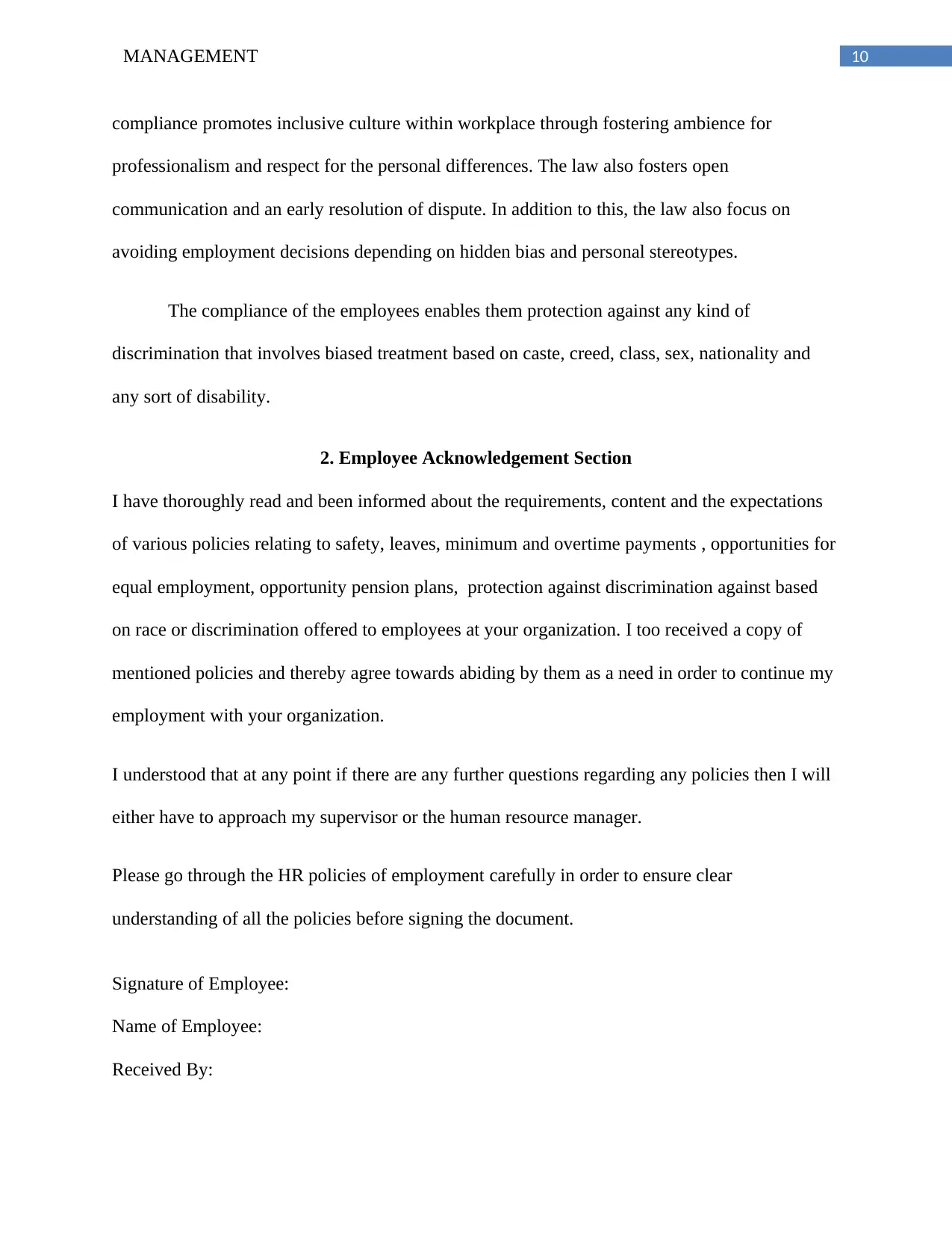
10MANAGEMENT
compliance promotes inclusive culture within workplace through fostering ambience for
professionalism and respect for the personal differences. The law also fosters open
communication and an early resolution of dispute. In addition to this, the law also focus on
avoiding employment decisions depending on hidden bias and personal stereotypes.
The compliance of the employees enables them protection against any kind of
discrimination that involves biased treatment based on caste, creed, class, sex, nationality and
any sort of disability.
2. Employee Acknowledgement Section
I have thoroughly read and been informed about the requirements, content and the expectations
of various policies relating to safety, leaves, minimum and overtime payments , opportunities for
equal employment, opportunity pension plans, protection against discrimination against based
on race or discrimination offered to employees at your organization. I too received a copy of
mentioned policies and thereby agree towards abiding by them as a need in order to continue my
employment with your organization.
I understood that at any point if there are any further questions regarding any policies then I will
either have to approach my supervisor or the human resource manager.
Please go through the HR policies of employment carefully in order to ensure clear
understanding of all the policies before signing the document.
Signature of Employee:
Name of Employee:
Received By:
compliance promotes inclusive culture within workplace through fostering ambience for
professionalism and respect for the personal differences. The law also fosters open
communication and an early resolution of dispute. In addition to this, the law also focus on
avoiding employment decisions depending on hidden bias and personal stereotypes.
The compliance of the employees enables them protection against any kind of
discrimination that involves biased treatment based on caste, creed, class, sex, nationality and
any sort of disability.
2. Employee Acknowledgement Section
I have thoroughly read and been informed about the requirements, content and the expectations
of various policies relating to safety, leaves, minimum and overtime payments , opportunities for
equal employment, opportunity pension plans, protection against discrimination against based
on race or discrimination offered to employees at your organization. I too received a copy of
mentioned policies and thereby agree towards abiding by them as a need in order to continue my
employment with your organization.
I understood that at any point if there are any further questions regarding any policies then I will
either have to approach my supervisor or the human resource manager.
Please go through the HR policies of employment carefully in order to ensure clear
understanding of all the policies before signing the document.
Signature of Employee:
Name of Employee:
Received By:
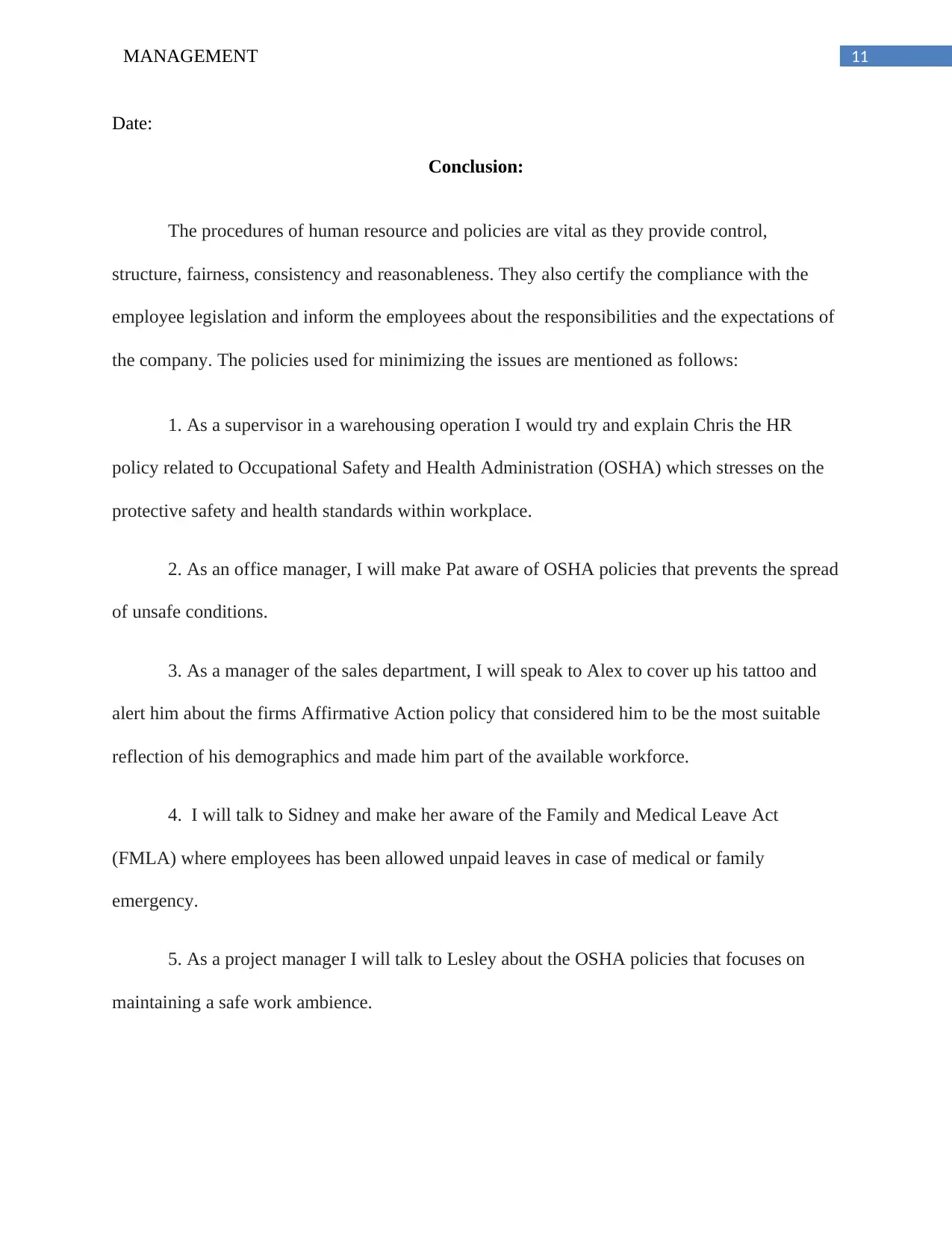
11MANAGEMENT
Date:
Conclusion:
The procedures of human resource and policies are vital as they provide control,
structure, fairness, consistency and reasonableness. They also certify the compliance with the
employee legislation and inform the employees about the responsibilities and the expectations of
the company. The policies used for minimizing the issues are mentioned as follows:
1. As a supervisor in a warehousing operation I would try and explain Chris the HR
policy related to Occupational Safety and Health Administration (OSHA) which stresses on the
protective safety and health standards within workplace.
2. As an office manager, I will make Pat aware of OSHA policies that prevents the spread
of unsafe conditions.
3. As a manager of the sales department, I will speak to Alex to cover up his tattoo and
alert him about the firms Affirmative Action policy that considered him to be the most suitable
reflection of his demographics and made him part of the available workforce.
4. I will talk to Sidney and make her aware of the Family and Medical Leave Act
(FMLA) where employees has been allowed unpaid leaves in case of medical or family
emergency.
5. As a project manager I will talk to Lesley about the OSHA policies that focuses on
maintaining a safe work ambience.
Date:
Conclusion:
The procedures of human resource and policies are vital as they provide control,
structure, fairness, consistency and reasonableness. They also certify the compliance with the
employee legislation and inform the employees about the responsibilities and the expectations of
the company. The policies used for minimizing the issues are mentioned as follows:
1. As a supervisor in a warehousing operation I would try and explain Chris the HR
policy related to Occupational Safety and Health Administration (OSHA) which stresses on the
protective safety and health standards within workplace.
2. As an office manager, I will make Pat aware of OSHA policies that prevents the spread
of unsafe conditions.
3. As a manager of the sales department, I will speak to Alex to cover up his tattoo and
alert him about the firms Affirmative Action policy that considered him to be the most suitable
reflection of his demographics and made him part of the available workforce.
4. I will talk to Sidney and make her aware of the Family and Medical Leave Act
(FMLA) where employees has been allowed unpaid leaves in case of medical or family
emergency.
5. As a project manager I will talk to Lesley about the OSHA policies that focuses on
maintaining a safe work ambience.
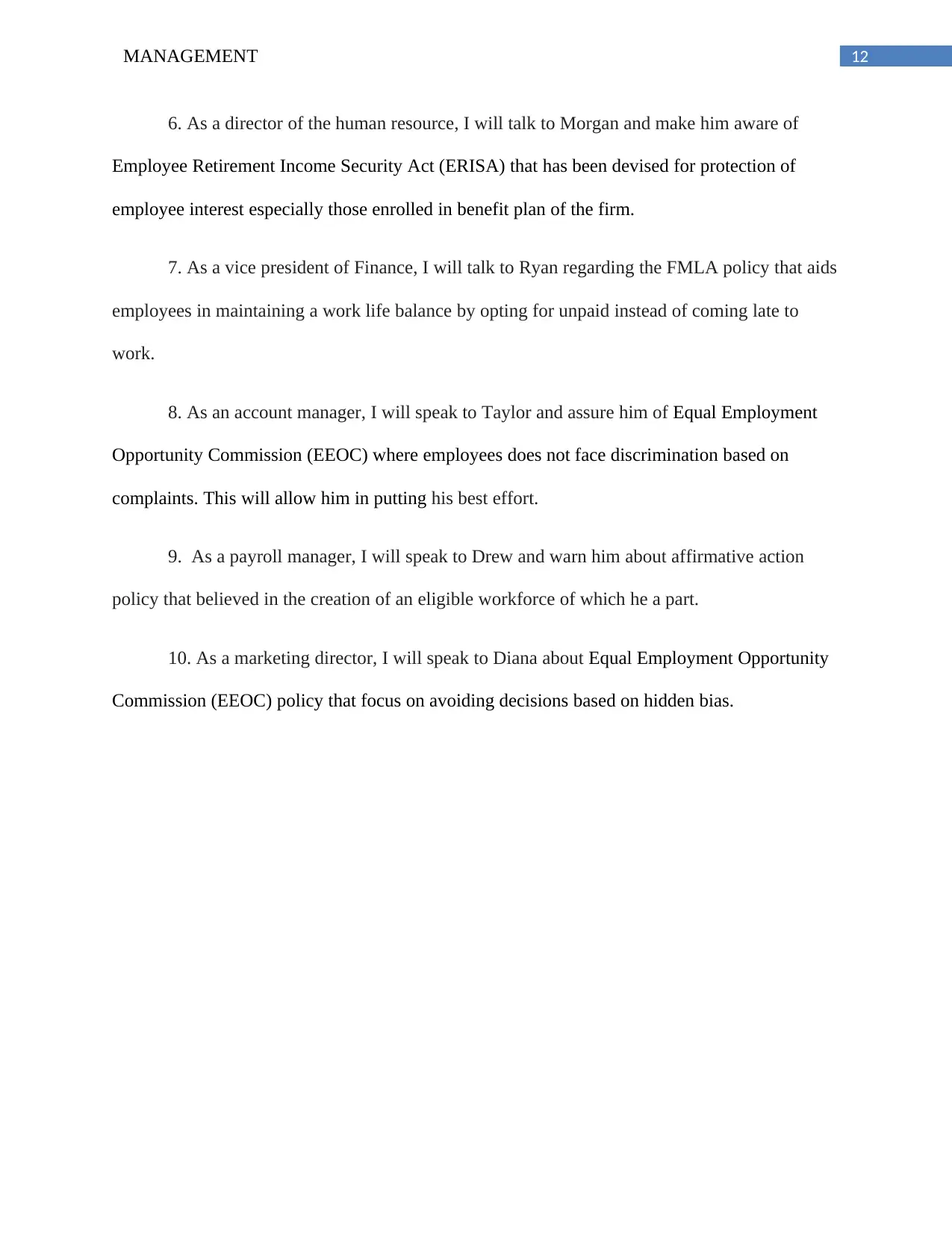
12MANAGEMENT
6. As a director of the human resource, I will talk to Morgan and make him aware of
Employee Retirement Income Security Act (ERISA) that has been devised for protection of
employee interest especially those enrolled in benefit plan of the firm.
7. As a vice president of Finance, I will talk to Ryan regarding the FMLA policy that aids
employees in maintaining a work life balance by opting for unpaid instead of coming late to
work.
8. As an account manager, I will speak to Taylor and assure him of Equal Employment
Opportunity Commission (EEOC) where employees does not face discrimination based on
complaints. This will allow him in putting his best effort.
9. As a payroll manager, I will speak to Drew and warn him about affirmative action
policy that believed in the creation of an eligible workforce of which he a part.
10. As a marketing director, I will speak to Diana about Equal Employment Opportunity
Commission (EEOC) policy that focus on avoiding decisions based on hidden bias.
6. As a director of the human resource, I will talk to Morgan and make him aware of
Employee Retirement Income Security Act (ERISA) that has been devised for protection of
employee interest especially those enrolled in benefit plan of the firm.
7. As a vice president of Finance, I will talk to Ryan regarding the FMLA policy that aids
employees in maintaining a work life balance by opting for unpaid instead of coming late to
work.
8. As an account manager, I will speak to Taylor and assure him of Equal Employment
Opportunity Commission (EEOC) where employees does not face discrimination based on
complaints. This will allow him in putting his best effort.
9. As a payroll manager, I will speak to Drew and warn him about affirmative action
policy that believed in the creation of an eligible workforce of which he a part.
10. As a marketing director, I will speak to Diana about Equal Employment Opportunity
Commission (EEOC) policy that focus on avoiding decisions based on hidden bias.
Paraphrase This Document
Need a fresh take? Get an instant paraphrase of this document with our AI Paraphraser
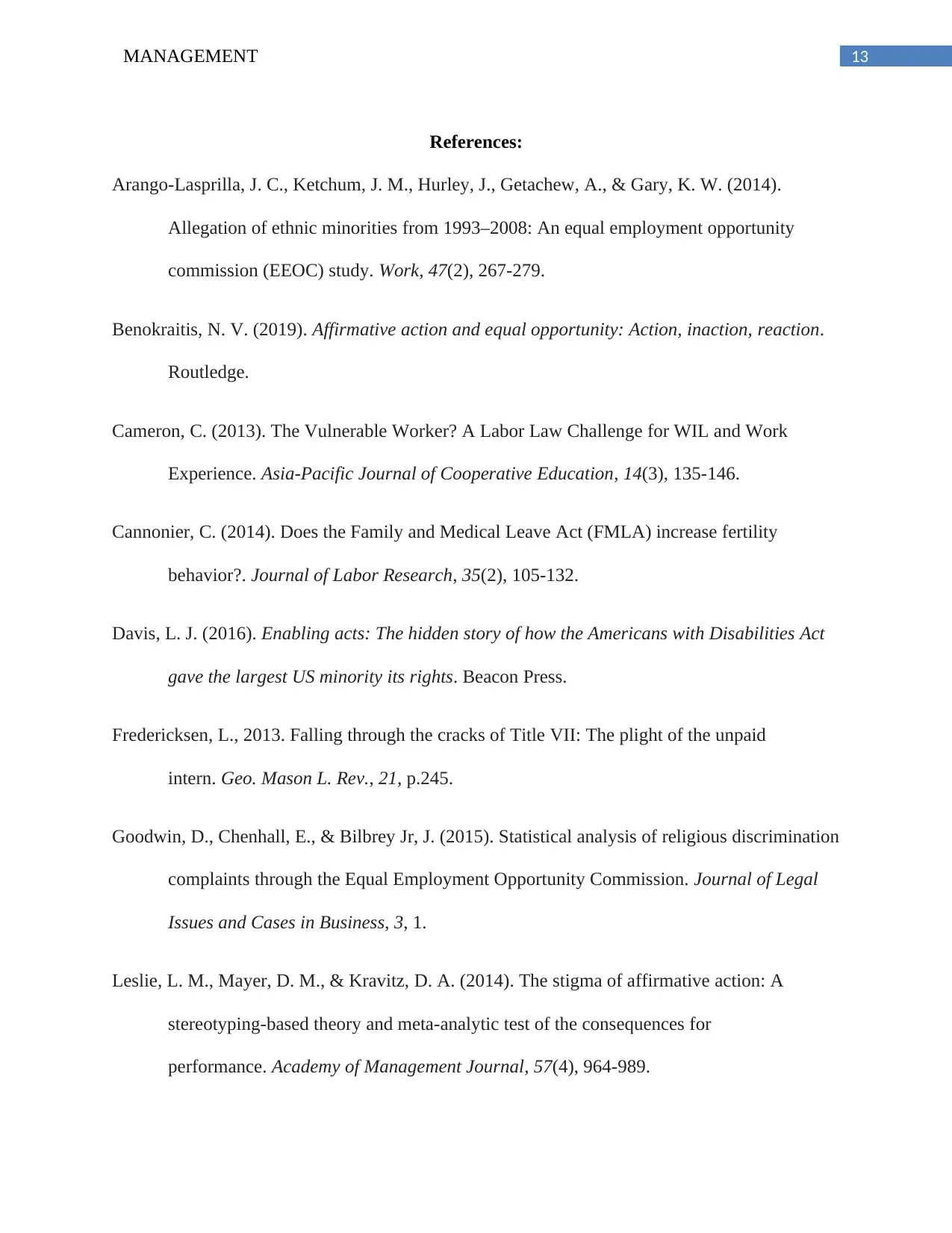
13MANAGEMENT
References:
Arango-Lasprilla, J. C., Ketchum, J. M., Hurley, J., Getachew, A., & Gary, K. W. (2014).
Allegation of ethnic minorities from 1993–2008: An equal employment opportunity
commission (EEOC) study. Work, 47(2), 267-279.
Benokraitis, N. V. (2019). Affirmative action and equal opportunity: Action, inaction, reaction.
Routledge.
Cameron, C. (2013). The Vulnerable Worker? A Labor Law Challenge for WIL and Work
Experience. Asia-Pacific Journal of Cooperative Education, 14(3), 135-146.
Cannonier, C. (2014). Does the Family and Medical Leave Act (FMLA) increase fertility
behavior?. Journal of Labor Research, 35(2), 105-132.
Davis, L. J. (2016). Enabling acts: The hidden story of how the Americans with Disabilities Act
gave the largest US minority its rights. Beacon Press.
Fredericksen, L., 2013. Falling through the cracks of Title VII: The plight of the unpaid
intern. Geo. Mason L. Rev., 21, p.245.
Goodwin, D., Chenhall, E., & Bilbrey Jr, J. (2015). Statistical analysis of religious discrimination
complaints through the Equal Employment Opportunity Commission. Journal of Legal
Issues and Cases in Business, 3, 1.
Leslie, L. M., Mayer, D. M., & Kravitz, D. A. (2014). The stigma of affirmative action: A
stereotyping-based theory and meta-analytic test of the consequences for
performance. Academy of Management Journal, 57(4), 964-989.
References:
Arango-Lasprilla, J. C., Ketchum, J. M., Hurley, J., Getachew, A., & Gary, K. W. (2014).
Allegation of ethnic minorities from 1993–2008: An equal employment opportunity
commission (EEOC) study. Work, 47(2), 267-279.
Benokraitis, N. V. (2019). Affirmative action and equal opportunity: Action, inaction, reaction.
Routledge.
Cameron, C. (2013). The Vulnerable Worker? A Labor Law Challenge for WIL and Work
Experience. Asia-Pacific Journal of Cooperative Education, 14(3), 135-146.
Cannonier, C. (2014). Does the Family and Medical Leave Act (FMLA) increase fertility
behavior?. Journal of Labor Research, 35(2), 105-132.
Davis, L. J. (2016). Enabling acts: The hidden story of how the Americans with Disabilities Act
gave the largest US minority its rights. Beacon Press.
Fredericksen, L., 2013. Falling through the cracks of Title VII: The plight of the unpaid
intern. Geo. Mason L. Rev., 21, p.245.
Goodwin, D., Chenhall, E., & Bilbrey Jr, J. (2015). Statistical analysis of religious discrimination
complaints through the Equal Employment Opportunity Commission. Journal of Legal
Issues and Cases in Business, 3, 1.
Leslie, L. M., Mayer, D. M., & Kravitz, D. A. (2014). The stigma of affirmative action: A
stereotyping-based theory and meta-analytic test of the consequences for
performance. Academy of Management Journal, 57(4), 964-989.
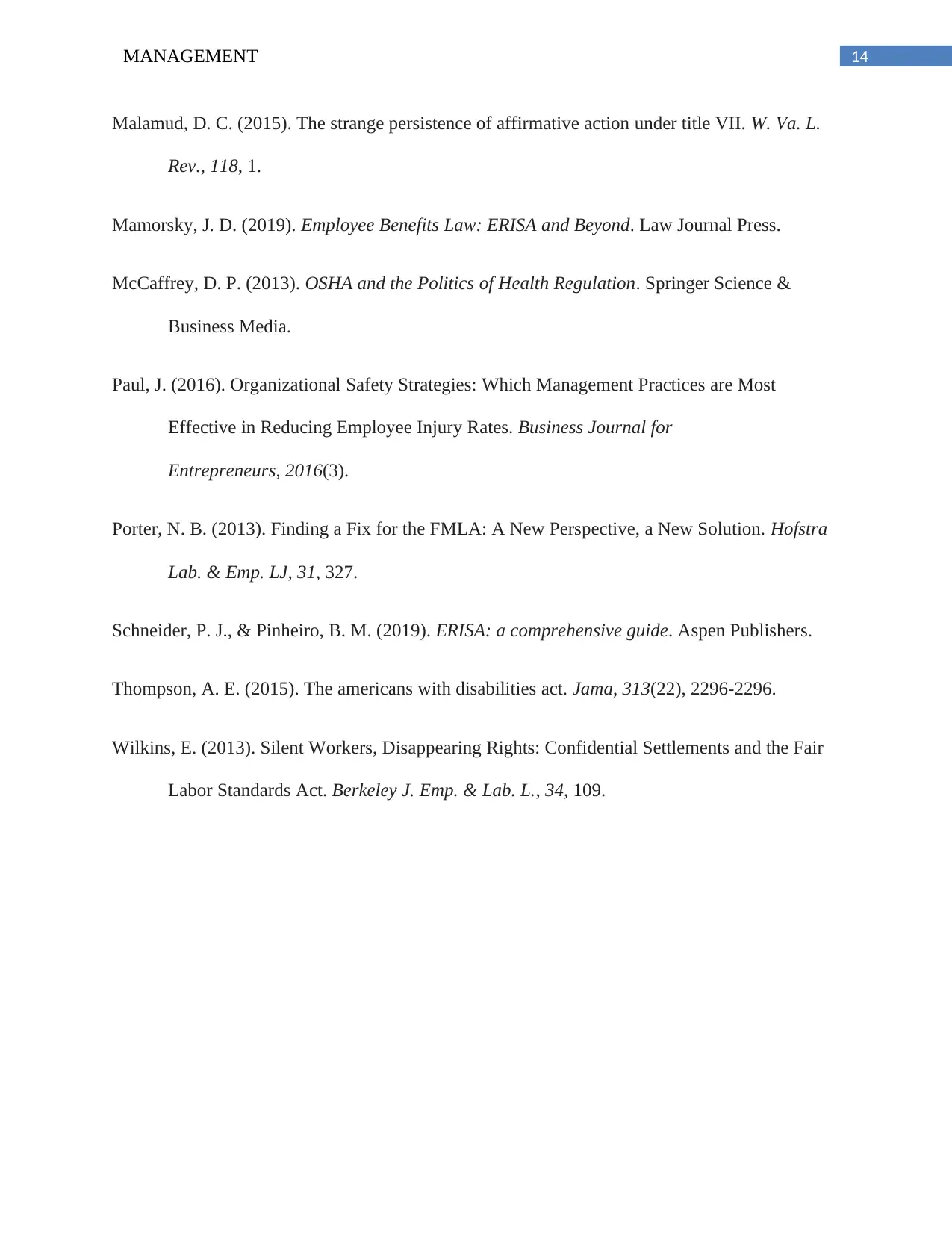
14MANAGEMENT
Malamud, D. C. (2015). The strange persistence of affirmative action under title VII. W. Va. L.
Rev., 118, 1.
Mamorsky, J. D. (2019). Employee Benefits Law: ERISA and Beyond. Law Journal Press.
McCaffrey, D. P. (2013). OSHA and the Politics of Health Regulation. Springer Science &
Business Media.
Paul, J. (2016). Organizational Safety Strategies: Which Management Practices are Most
Effective in Reducing Employee Injury Rates. Business Journal for
Entrepreneurs, 2016(3).
Porter, N. B. (2013). Finding a Fix for the FMLA: A New Perspective, a New Solution. Hofstra
Lab. & Emp. LJ, 31, 327.
Schneider, P. J., & Pinheiro, B. M. (2019). ERISA: a comprehensive guide. Aspen Publishers.
Thompson, A. E. (2015). The americans with disabilities act. Jama, 313(22), 2296-2296.
Wilkins, E. (2013). Silent Workers, Disappearing Rights: Confidential Settlements and the Fair
Labor Standards Act. Berkeley J. Emp. & Lab. L., 34, 109.
Malamud, D. C. (2015). The strange persistence of affirmative action under title VII. W. Va. L.
Rev., 118, 1.
Mamorsky, J. D. (2019). Employee Benefits Law: ERISA and Beyond. Law Journal Press.
McCaffrey, D. P. (2013). OSHA and the Politics of Health Regulation. Springer Science &
Business Media.
Paul, J. (2016). Organizational Safety Strategies: Which Management Practices are Most
Effective in Reducing Employee Injury Rates. Business Journal for
Entrepreneurs, 2016(3).
Porter, N. B. (2013). Finding a Fix for the FMLA: A New Perspective, a New Solution. Hofstra
Lab. & Emp. LJ, 31, 327.
Schneider, P. J., & Pinheiro, B. M. (2019). ERISA: a comprehensive guide. Aspen Publishers.
Thompson, A. E. (2015). The americans with disabilities act. Jama, 313(22), 2296-2296.
Wilkins, E. (2013). Silent Workers, Disappearing Rights: Confidential Settlements and the Fair
Labor Standards Act. Berkeley J. Emp. & Lab. L., 34, 109.
1 out of 15
Related Documents
Your All-in-One AI-Powered Toolkit for Academic Success.
+13062052269
info@desklib.com
Available 24*7 on WhatsApp / Email
![[object Object]](/_next/static/media/star-bottom.7253800d.svg)
Unlock your academic potential
© 2024 | Zucol Services PVT LTD | All rights reserved.





